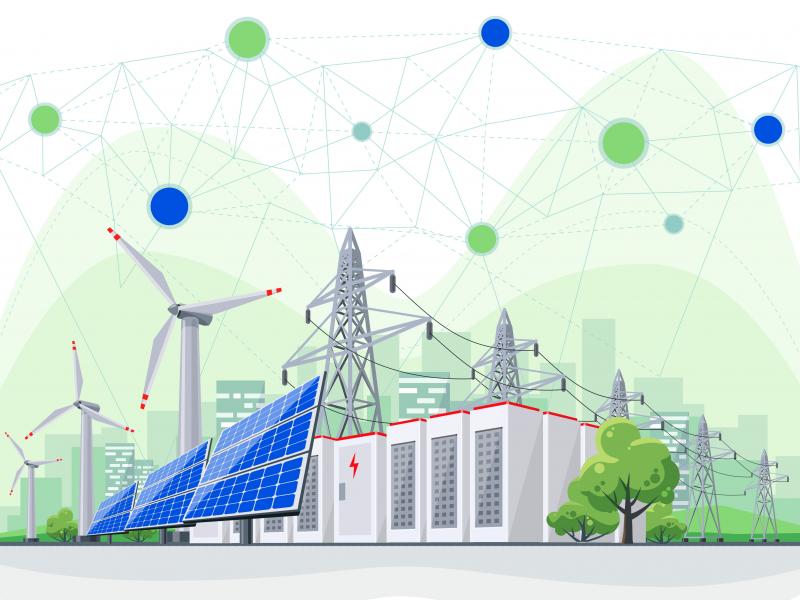
Blockchain for Cybersecurity and Grid Modernization

As the United States transitions to a more modern and dynamic energy infrastructure, new challenges arise. Greater integration of distributed energy generation resources and grid-connected smart devices leads to an unprecedented volume, speed, and complexity of data transfers and transactions. These new developments present a major security challenge for utilities and put an already vulnerable power grid at increased risk of cyberattacks. To overcome these challenges, Pacific Northwest National Laboratory (PNNL) is evaluating and testing the use of distributed ledger technologies (DLTs) such as blockchains to support the security, reliability, and resilience of the nation’s power grid.
Blockchain technology, like many DLTs, has three high-level attributes:
- An immutable digital ledger that securely records transactions without the need for a centralized authority
- Distributed consensus to achieve fault tolerance, such as byzantine and crash fault tolerance
- Smart contracts for automated interaction between systems
Any data exchanged on the blockchain is encrypted, making it nearly impossible to alter or hack. These features make it a particularly powerful solution that can contribute toward improving cybersecurity of critical energy infrastructure, supply chain management, transactive energy systems or local energy markets, and distributed coordination between grid entities. The features inherent to blockchains—decentralization, immutability, and encryption—are essential design criteria for a modern and secure power grid.
PNNL is drawing from a wealth of experience and capabilities in cybersecurity research to develop novel security solutions using blockchain technology for the power grid. PNNL grid and cyber researchers are pioneering new applications for blockchain technology to solve key challenges associated with building a cleaner, resilient, and flexible power grid.
Grid-cyber and energy systems blockchain projects and engagements at PNNL
Blockchain for Optimized Security and Energy Management (BLOSEM) is a multi-laboratory collaboration established to develop energy-sector guidance, standardized metrics, and testing environments for technology maturation of novel blockchain-based concepts for device security, secure communications, and grid resilience.
Keyless Infrastructure Security Solutions (KISS) is a project to develop a keyless signature infrastructure (KSI) used to verify the integrity of real-time energy transactions. The KSI is integrated with an open-standard, PNNL-developed distributed control and sensing software platform called VOLTTRON. The research team demonstrated the KISS solution in a utility-control-center-scale laboratory environment supporting two use cases: (1) maintain the integrity of data at rest in utility-scale historians (emulated in the PNNL Energy Management System Lab), and (2) assure data-in-transit integrity in utility control center to substation communications (emulated in Washington State University’s Distribution System Smart City testbed). Partners include Guardtime, LLC, Washington State University, Tennessee Valley Authority, Siemens, and the U.S. Department of Defense’s Homeland Defense and Security Information Analysis Center.
Blockchain Smart Contracts for Transactive Energy Systems is geared toward designing technology agnostic smart contract templates for different phases of the energy service interface model. With blockchain-based smart contracts, control systems can automatically verify and authenticate the trustworthiness of a large number of energy transactions in near real time. Smart contracts are a computer program that runs and records a contract or agreement after certain conditions are met. In the future, smart contracts will enable homeowners to securely and reliably buy and sell power generated from distributed energy sources—like rooftop solar panels, on-site energy storage, or a grid-interactive home energy management system—in an open energy market. The PNNL research team demonstrated a methodical and scalable process that can be used by the technology adopters to map the technical and engineering requirements of a use case to blockchain features.
Blockchain Applicability Framework is designed to help blockchain and DLT technology adopters evaluate the applicability and potential value proposition of blockchain to their use cases. The PNNL research team is making significant enhancements to the web-based tool that is designed based on the above research paper and scheduled for release in 2021. PNNL is working with Ecolong to publish the tool. Before investing any resources into building a blockchain-based solution, the technology adopters can use this tool to determine if they need blockchain and, if so, what kind of architecture is most appropriate for their use case.
Blockchain Patents
Since 2017, the power and energy researchers at PNNL have filed four international patents and published over 15 articles with over 200 citations. PNNL actively engages with more than 15 external partners, advisors, and collaborators across various blockchain organizations in power and energy research projects. Here is a list of patents:
- Blockchain Applicability Framework; patent pending, filed July 2020. U.S. Patent Application No.16/926,605.
- Blockchain Cybersecurity Audit Platform; patent pending, filed July 2019. U.S. Patent Application No. 16/503,038.
- Blockchain-based cybersecurity solution to secure data at rest, data in transit, and autonomous registration, verification, and traceability of systems; patent pending, filed July 2020. U.S. Patent Application No. 16/926,600.
- Blockchain smart contracts for Energy Markets, provisional patent filed December 2020. U.S. Provisional Patent Application No. 16,926,600.

